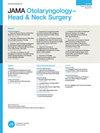Giant-cell lesions of the facial skeleton.
引用次数: 46
Abstract
Differentiation of brown tumors of primary or secondary hyperparathyroidism, giant-cell reparative granulomas, and the "true" giant-cell tumors requires consideration of the clinical presentation, anatomic location, roentgenographic features, and results of metabolic studies. These lesions are indistinguishable by histologic appearance alone. Of the 32 giant-cell lesions of bone that were treated at UCLA during the preceding 20 years, seven were from the head and neck region. Four giant-cell reparative granulomas were easily accessible and were treated by local excision. The three "true" giant-cell tumors were found to be in inaccessible locations and thus were treated with full course irradiation. This resulted in tumor shrinkage, but it is probably not curative. Tumor type, location, and clinical setting are important in planning treatment of these lesions.面部骨骼巨细胞病变。
原发性或继发性甲状旁腺功能异常棕色肿瘤、巨细胞修复性肉芽肿和“真正的”巨细胞肿瘤的鉴别需要考虑临床表现、解剖位置、x线表现和代谢研究结果。这些病变仅凭组织学外观难以区分。在加州大学洛杉矶分校过去20年间治疗的32例骨巨细胞病变中,有7例来自头颈部。4例巨细胞修复性肉芽肿易接触,局部切除治疗。三个“真正的”巨细胞肿瘤被发现在难以接近的位置,因此接受了全程照射治疗。这导致肿瘤缩小,但可能无法治愈。肿瘤的类型,位置和临床环境是重要的计划治疗这些病变。
本文章由计算机程序翻译,如有差异,请以英文原文为准。
求助全文
约1分钟内获得全文
求助全文

 求助内容:
求助内容: 应助结果提醒方式:
应助结果提醒方式:


